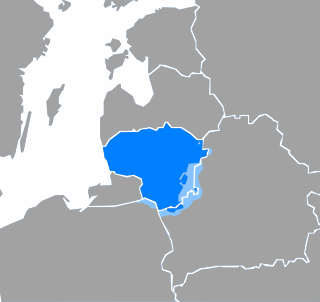| Lithuanian | |
|---|---|
| lietuvių kalba | |
| Pronunciation | [lʲiəˈtʊvʲuː kɐɫˈbɐ] |
| Native to | Lithuania |
| Region | Baltic |
| Ethnicity | Lithuanians |
Native speakers | 3.0 million (2012)[1] |
Indo-European
| |
Early forms | |
| Dialects | |
| Latin (Lithuanian alphabet) Lithuanian Braille | |
| Official status | |
Official language in | |
Recognised minority language in | |
| Regulated by | Commission of the Lithuanian Language |
| Language codes | |
| ISO 639-1 | lt |
| ISO 639-2 | lit |
| ISO 639-3 | Either:lit – Modern Lithuanianolt – Old Lithuanian |
| Glottolog | lith1251 |
| Linguasphere | 54-AAA-a |
 Map of areas where Lithuanian is spoken as a majority language (marked in dark blue) and minority language (marked in light blue) | |
Lithuanian (endonym: lietuvių kalba, pronounced [lʲiəˈtʊvʲuː kɐɫˈbɐ]) is an East Baltic language belonging to the Baltic branch of the Indo-European language family. It is the language of Lithuanians and the official language of Lithuania as well as one of the official languages of the European Union. There are approximately 2.8 million[2] native Lithuanian speakers in Lithuania and about 1 million speakers elsewhere. Around half a million inhabitants of Lithuania of non-Lithuanian background speak Lithuanian daily as a second language.
Lithuanian is closely related to neighbouring Latvian, though the two languages are not mutually intelligible. It is written in a Latin script. In some respects, some linguists consider it to be the most conservative of the existing Indo-European languages, retaining features of the Proto-Indo-European language that had disappeared through development from other descendant languages.[3][4][5]
- ^ Lithuanian language at Ethnologue (19th ed., 2016)

- ^ Rodiklių duomenų bazė. "Oficialiosios statistikos portalas". osp.stat.gov.lt (in Lithuanian).
- ^ Zinkevičius, Z. (1993). Rytų Lietuva praeityje ir dabar [Eastern Lithuania in the Past and Now] (in Lithuanian). Vilnius: Mokslo ir enciklopedijų leidykla. p. 9. ISBN 5-420-01085-2.
...linguist generally accepted that Lithuanian is the most archaic among living Indo-European languages...
- ^ "Lithuanian Language". Encyclopedia Britannica.
- ^ Bonifacas, Stundžia (20 November 2021). "How did Vytautas the Great speak and would we manage to have a conversation with VI century Lithuanians?". 15min. Retrieved 20 November 2021.